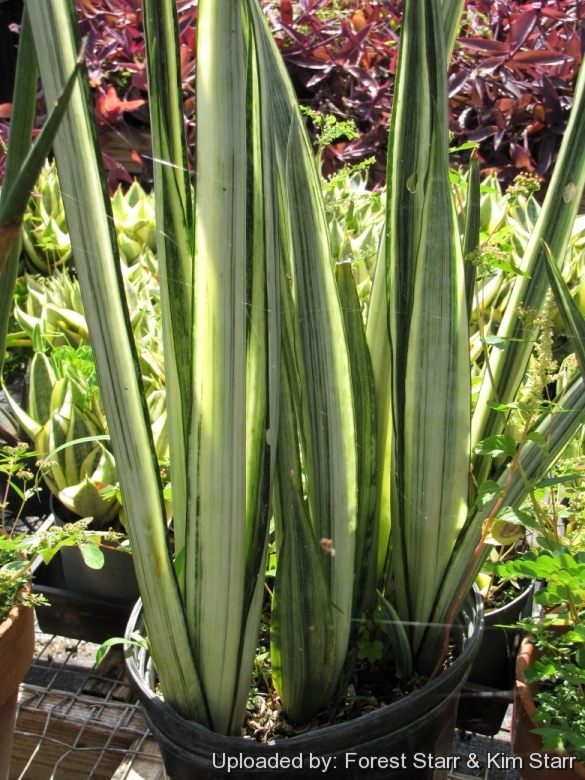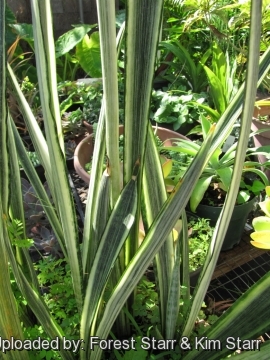




Your support is critical to our success.
Accepted Scientific Name: Sansevieria trifasciata cv. Bantel's Sensation

Variegated different form at Kihei, Maui, Hawaii, USA. February 15, 2011.
Origin and Habitat: Garden origin. The natural species is native to tropical West Africa from Nigeria east to the Congo.
Synonyms:
ENGLISH: White Sansevieria, White Snake plant, White Striped Mother-in-law's Tongue, White Stripped Snake plant, , White Striped Sansevieria
Description: Sansevieria trifasciataSN|19026]]SN|19026]] cv. Bantel's Sensation (a.k.a. White Stripped Sansevieria, White Stripped snake plant) is a beautifully elegant variegated cultivar with 60-90 cn long, 4 cm wide wide dark green leaves that are dramatically banded with snow white streaks. It is a stemless perennial succulent herb forming dense stands, spreading by way of its creeping rhizome. This species can bloom in summer with sweetly fragrant greenish white flowers but this cultivar rarely seems to do so.
History: This plant was discovered by Gustav Bantel of St. Louis, Missouri who patented the plant (PP 796) in 1948. On the patent application Mr. Bantel stated "The primary object in carrying out this invention was to fix the unusual dark olive green leaves and silver white longitudinal stripes of the leaves, their slender transversely concave rapier shape, and their nearly vertical stiff erectness, diverging upwardly from a short basal rosette." He described the plant as "similar to ordinary sansevieria … however, it differs distinctly in having its slender ensiform leaves stiffly erect, deeply channeled in the lower portion, extending to 70 cm or more in height with a greatest width about 3-4 well above the middle and then gradually tapering in graceful curvature to an acute stiff point … In colour the inner concave face is mostly dark olive green streaked with silver white with outer convexly curved face much lighter with dark green streaks narrower and more numerous and interspersed with narrow streaks of silvery white." Sansevieria trifasciataSN|19026]]SN|19026]] 'Bantel's Sensation' won the coveted Royal Horticultural Society's Award of Garden Merit in 1993.
Rhizome: Sympodial, sometimes above ground, sometimes underground, robust, and yellowish 1.3 to 2.5 cm thick.
Leaves: 1–2(rarely to 6), vertical, very erect, linear-lanceolate and flat, tappering gradually from the middle or above, fibrous, fleshy, 45-to over 1 m tall, 3-4 cm wide, and channelled at the base, dark olive green with silver white longitudinal stripes from base to apex. The leaf surface is smooth.
Inflorescence (raceme): Erect (30–)40–75 cm high, loosely filled with three to eight flowers per bunch. Stalk 3–8 mm thick The bract is ovate or ovate-lanceolate, pointed, 3-12 mm long
Flowers:(1–)3–4 per cluster. Pedicels 50–85 mm long, upward-curved green with pale green dots. Flowers pale greenish or greenish-white, perianth is 1.9–2.3(-3)cm long, greenish-white, and scented. The sepals are linear and greenish. The stamens are 0.8 cm long and the style is 1.5 cm long.
Fruits (berries): Globose, 8-9 mm in diameter, bright orange, and contain 1-2(-3) seeds.
Subspecies, varieties, forms and cultivars of plants belonging to the Sansevieria trifasciata group
 Sansevieria trifasciata Prain: has upright, sword-shaped leaves from a basal rosette, dark green with horizontal bands of light greyish-green. Distribution: West Africa from Nigeria east to the Congo.
Sansevieria trifasciata Prain: has upright, sword-shaped leaves from a basal rosette, dark green with horizontal bands of light greyish-green. Distribution: West Africa from Nigeria east to the Congo. Sansevieria trifasciata cv. Bantel's Sensation: (White sansevieria) - A beautifully elegant variegated plant with 60-90 cm long by 4 cm inch wide dark green leaves that are dramatically banded with snow white streaks.
Sansevieria trifasciata cv. Bantel's Sensation: (White sansevieria) - A beautifully elegant variegated plant with 60-90 cm long by 4 cm inch wide dark green leaves that are dramatically banded with snow white streaks.  Sansevieria trifasciata cv. Golden Hahnii: (Golden birdnest sansevieria) has attractive yellow/golden leaves with a combination of marginal and internal green stripes of variable width/length which are parallel with the veins of the leaf.
Sansevieria trifasciata cv. Golden Hahnii: (Golden birdnest sansevieria) has attractive yellow/golden leaves with a combination of marginal and internal green stripes of variable width/length which are parallel with the veins of the leaf. Sansevieria trifasciata cv. hahnii: a.k.a. Bird's Nest Sansevieria is a dwarf version with rosettes of leaves banded green and dark green.
Sansevieria trifasciata cv. hahnii: a.k.a. Bird's Nest Sansevieria is a dwarf version with rosettes of leaves banded green and dark green. Sansevieria trifasciata cv. Laurentii: similar in growth and appearance to Sansevieria trifasciata, but has broad creamy-yellow, longitudinal stripes on margins.
Sansevieria trifasciata cv. Laurentii: similar in growth and appearance to Sansevieria trifasciata, but has broad creamy-yellow, longitudinal stripes on margins. Sansevieria trifasciata cv. Moonshine: has pale green (nearly silver) leaves, ageing to an olive colour with slight cross banding with a narrow dark green margin.
Sansevieria trifasciata cv. Moonshine: has pale green (nearly silver) leaves, ageing to an olive colour with slight cross banding with a narrow dark green margin.
Bibliography: Major references and further lectures
1) San Marcos Growers contributors “Sansevieria trifasciata 'Bantel's Sensation' - White Striped Sansevieria” San Marcos Growers <http://www.smgrowers.com>. Web. 1 Jan. 2015.
2) Forest & Kim Starr “Sansevieria trifasciata (Mother in law's tongue, snake plant)”. Plants of Hawaii. <http://www.starrenvironmental.com>. Web. 1 Jan. 2015.
3) Wikipedia contributors. "Sansevieria trifasciata." Wikipedia, The Free Encyclopedia. Wikipedia, The Free Encyclopedia, 28 Oct. 2014. Web. 1 Jan. 2015.
4) Geoffrey Mwachala & Paul Mbugua “Flora of Tropical East Africa” 2007
5) Watt, J., and Breyer-Brandwijk, M., “The Medical and Poisonous Plants of Southern and Eastern Africa” E & S Livingstone, Edinburgh, 1962
6) Mitchell, J. and Rook, A., “Botanical Dermatology. Plants Injurious to the Skin.” Greengrass, Vancouver 1979
7) Spoerke, Susan C. Smolinske “Toxicity of Houseplants” CRC Press, 03 July 1990
8) Christophe Wiart “Medicinal Plants of China, Korea, and Japan: Bioresources for Tomorrow’s Drugs and Cosmetics” CRC Press, 11 May 2012
9) James Del Prince “Interior Plantscaping: Principles and Practices” Cengage Learning, 12 October 2012
10) Burkill, H.M. “The useful plants of west tropical Africa” Vol 3 1985.
11) Nicholas Edward Brown “Sansevieria - a monograph of all the known species (with plates).” In: Bulletin of Miscellaneous Information, Heft 5. Royal Botanic Gardens, Kew 1915, S. 239–241 (online).
12) Peter A. Mansfeld: “Die Gattung Sansevieria – Alle Arten und ihre Pflege.” BoD, Hamburg 2013
13) Urs Eggli, Leonard E. Newton: “Etymological Dictionary of Succulent Plant Names.” Birkhäuser 2004.
14) Jo Jarvis, “Foliage for Florists” 2006
15) Urs Eggli “Illustrated Handbook of Succulent Plants: Monocotyledons: Monocotyledons” Springer Science & Business Media, 17 July 2001

Variegated different form at Kihei, Maui, Hawaii, USA. February 15, 2011. (Sansevieria trifasciata cv. Bantel's Sensation) Photo by: Forest Starr & Kim Starr
The gallery now contains thousands of pictures, however it is possible to do even more. We are, of course, seeking photos of species not yet shown in the gallery but not only that, we are also looking for better pictures than those already present. Read More...
Cultivation and Propagation: Sansevieria trifasciataSN|19026]]SN|19026]] is slow-growing but easy to cultivate. It is a very drought tolerant plant, but not as cold hardy as some. It needs heat and dry air in Winter and half shade in Summer. Does best as a pot plant. Like all snake plants, it is very efficient in removing pollutants from indoor air.
Soil: Use a well-drained potting mix consisting of 3 parts loam to 1 part of pumice.
Fertilization: They are fertilized once during the growing season with a balanced fertilizer.
Repotting: Transplant only when plant is pot-bound.
Watering Needs: The plants are very drought tolerant and are watered about every other week during the growing season, allow to dry somewhat between waterings. Water sparingly and not at all as temperatures dip in winter but can tolerate going months between watering.
Exposure: Bright filtered light. Will tolerate low light levels but grows best and flowers if given bright light and even tolerates full sun. Afternoon shade in summer.
Frost Tolerance: Avoid any frost. This species is dormant in winter, keep it at or around 4°C.
Outdoors: In the garden In mild to tropical climates it prefers semi-shade or shade and it is not fussy.
Aerosol salt tolerance: It is very tolerant of coastal and beach exposure.
Pests/Disease: Mealybugs and spider mites.
Use: It is a great container plant for interior or exterior use that needs little care. It makes a choice designer's architectural statement. It is popular as an ornamental plant as it is easy to culture and take care of in a home.
Propagation: They are propagated by cuttings or by divisions taken at any time. Cuttings should be at least 10 cm long and inserted in moist sand. A rhizome will emerge at the cut edge of the leaf. Variegated cultivars offspring will lack variegation if rooted from leaves.
| Your Actions | |
|---|---|
| Back to Sansevieria index | |
| Back to Dracaenaceae index | |
 |
Back to Succulents Encyclopedia index |
Privacy stantement - Terms and conditions - How to cite - About us - Feedback - Donate




